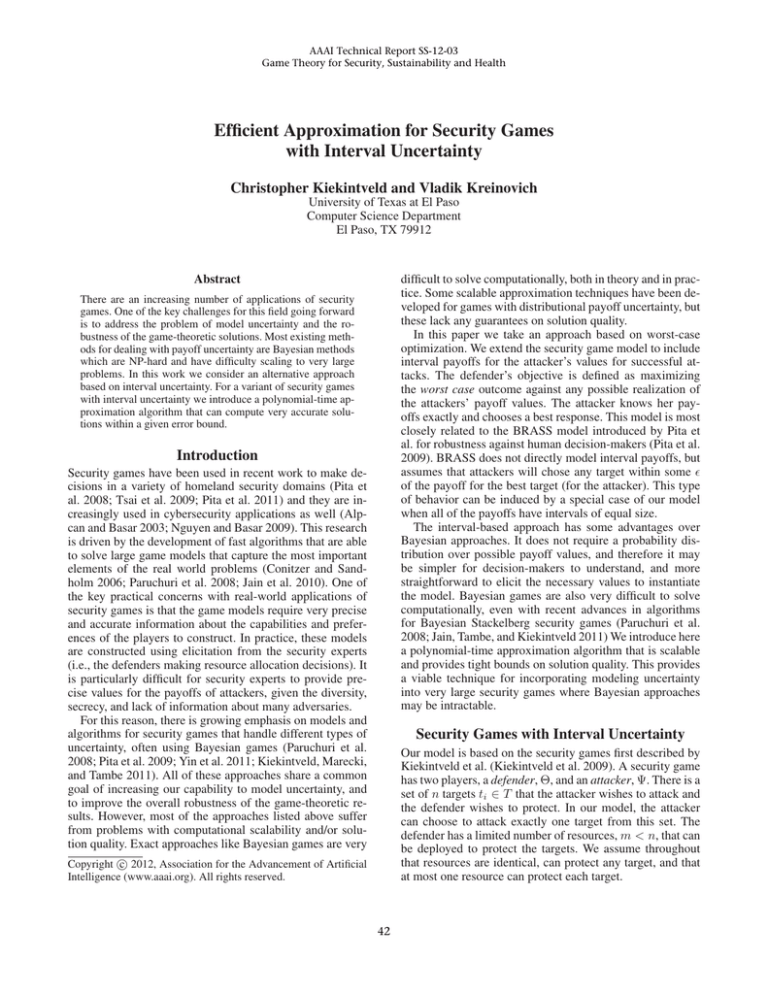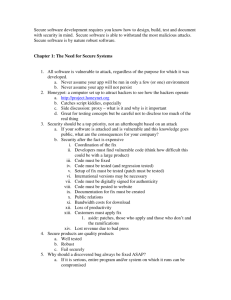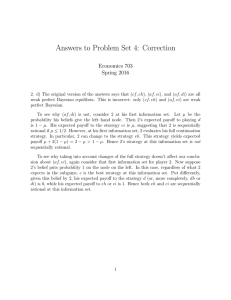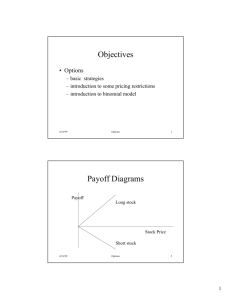Efficient Approximation for Security Games with Interval Uncertainty
advertisement

AAAI Technical Report SS-12-03
Game Theory for Security, Sustainability and Health
Efficient Approximation for Security Games
with Interval Uncertainty
Christopher Kiekintveld and Vladik Kreinovich
University of Texas at El Paso
Computer Science Department
El Paso, TX 79912
Abstract
difficult to solve computationally, both in theory and in practice. Some scalable approximation techniques have been developed for games with distributional payoff uncertainty, but
these lack any guarantees on solution quality.
In this paper we take an approach based on worst-case
optimization. We extend the security game model to include
interval payoffs for the attacker’s values for successful attacks. The defender’s objective is defined as maximizing
the worst case outcome against any possible realization of
the attackers’ payoff values. The attacker knows her payoffs exactly and chooses a best response. This model is most
closely related to the BRASS model introduced by Pita et
al. for robustness against human decision-makers (Pita et al.
2009). BRASS does not directly model interval payoffs, but
assumes that attackers will chose any target within some of the payoff for the best target (for the attacker). This type
of behavior can be induced by a special case of our model
when all of the payoffs have intervals of equal size.
The interval-based approach has some advantages over
Bayesian approaches. It does not require a probability distribution over possible payoff values, and therefore it may
be simpler for decision-makers to understand, and more
straightforward to elicit the necessary values to instantiate
the model. Bayesian games are also very difficult to solve
computationally, even with recent advances in algorithms
for Bayesian Stackelberg security games (Paruchuri et al.
2008; Jain, Tambe, and Kiekintveld 2011) We introduce here
a polynomial-time approximation algorithm that is scalable
and provides tight bounds on solution quality. This provides
a viable technique for incorporating modeling uncertainty
into very large security games where Bayesian approaches
may be intractable.
There are an increasing number of applications of security
games. One of the key challenges for this field going forward
is to address the problem of model uncertainty and the robustness of the game-theoretic solutions. Most existing methods for dealing with payoff uncertainty are Bayesian methods
which are NP-hard and have difficulty scaling to very large
problems. In this work we consider an alternative approach
based on interval uncertainty. For a variant of security games
with interval uncertainty we introduce a polynomial-time approximation algorithm that can compute very accurate solutions within a given error bound.
Introduction
Security games have been used in recent work to make decisions in a variety of homeland security domains (Pita et
al. 2008; Tsai et al. 2009; Pita et al. 2011) and they are increasingly used in cybersecurity applications as well (Alpcan and Basar 2003; Nguyen and Basar 2009). This research
is driven by the development of fast algorithms that are able
to solve large game models that capture the most important
elements of the real world problems (Conitzer and Sandholm 2006; Paruchuri et al. 2008; Jain et al. 2010). One of
the key practical concerns with real-world applications of
security games is that the game models require very precise
and accurate information about the capabilities and preferences of the players to construct. In practice, these models
are constructed using elicitation from the security experts
(i.e., the defenders making resource allocation decisions). It
is particularly difficult for security experts to provide precise values for the payoffs of attackers, given the diversity,
secrecy, and lack of information about many adversaries.
For this reason, there is growing emphasis on models and
algorithms for security games that handle different types of
uncertainty, often using Bayesian games (Paruchuri et al.
2008; Pita et al. 2009; Yin et al. 2011; Kiekintveld, Marecki,
and Tambe 2011). All of these approaches share a common
goal of increasing our capability to model uncertainty, and
to improve the overall robustness of the game-theoretic results. However, most of the approaches listed above suffer
from problems with computational scalability and/or solution quality. Exact approaches like Bayesian games are very
Security Games with Interval Uncertainty
Our model is based on the security games first described by
Kiekintveld et al. (Kiekintveld et al. 2009). A security game
has two players, a defender, Θ, and an attacker, Ψ. There is a
set of n targets ti ∈ T that the attacker wishes to attack and
the defender wishes to protect. In our model, the attacker
can choose to attack exactly one target from this set. The
defender has a limited number of resources, m < n, that can
be deployed to protect the targets. We assume throughout
that resources are identical, can protect any target, and that
at most one resource can protect each target.
c 2012, Association for the Advancement of Artificial
Copyright Intelligence (www.aaai.org). All rights reserved.
42
The attacker’s set of pure strategies consist of attacking
each of the n targets. The defender’s set of pure strategies
comprise all possible ways to assign the m resources to
the n targets. However, we can conveniently summarize the
defender’s strategy by defining the coverage vector which
gives the probability that there is a defender resource assigned to each individual target. Let us denote these probn
P
abilities by ci , so that
ci = m. The vector of coverage
In our model we cannot directly apply the idea of the attack set, but we can generalize this idea as follows. We define the potential attack set for a coverage strategy C to be
the set of all targets that could give the attacker the maximum expected value, for any realization of attacker payoffs
consistent with the payoff intervals. For every target, the attacker has a range of expected payoffs:
i=1
u,max
v max (ti ) = (1 − ci ) · UΨ
(ti )
(1)
u,min
UΨ
(ti ).
(2)
v
probabilities we denote by C.
If the attacker chooses to attack target ti , we call the attack successful if the target is left uncovered by the defender,
and unsuccessful if the target is covered. In the original security game model, there are four payoff values defined for
each target. The defender’s payoff for an uncovered attack
u
c
is denoted UΘ
(t), and for a covered attack UΘ
(t). Similarly,
u
c
UΨ (t) and UΨ (t) are the attacker’s payoffs in each case.
We modify this payoff structure in two ways. First, we
consider a restricted case where the payoffs for an unsucc
c
cessful attack are zero for both players (UΘ
(t) = UΨ
(t) = 0
for all t). Second, we introduce payoff intervals to repreu
sent the attacker’s payoffs. Rather than a single value UΨ
(t)
u,max
for each target, we have a pair of values, UΨ
(t) and
u,min
UΨ
(t), that represent the maximum and minimum values for a successful attack on target t. The idea of this approach is that the defender knows only that the attacker’s
payoffs lie within some possible range of values, and not
the precise value. For now we continue to represent the defender’s payoffs using a single value for each target, consistent with the idea that the defender has greater knowledge of
their own preferences than those of the attacker.
Security games are typically modeled as Stackelberg
games in which the attacker can observe the defender’s
strategy (c1 , . . . , cn ) before planning an attack (modeling
surveillance capabilities). We cannot use the standard solution concept of Strong Stackelberg Equilibrium because the
defender’s expected payoff is not well-defined. Instead, we
assume that the attacker knows the realization of the payoffs within the specified payoff intervals, but the defender
knows only that the payoffs lie within the given intervals.
Therefore, the defender does not have information about the
distribution of the payoffs within these intervals, and cannot
compute an expected payoff. Instead, we follow the literature on robust optimization and take a worst-case approach.
The defender’s goal in our framework is to select a coverage
vector, C, that maximizes the defenders worst-case payoff
over all of the possible ways that the attacker payoffs could
be chosen from the defined intervals.
min
(ti ) = (1 − ci ) ·
Observe that the attacker is always guaranteed a payoff of at
least the maximum of the minimum values over all targets;
let us denote this value by R = maxti v min (ti ). Given the
value of R we can identify the targets that could be attacked.
Any target ti with a maximum expected value v max (ti ) ≥ R
could be the best target for the attacker to attack. To see this,
suppose that the value for ti is maximal, and the values for
all other targets is minimal, so that the best possible value
for attacking any target other than ti is R. Therefore, the
potential attack set, Λ(C), is defined as:
Λ(C) = {ti : v max (ti ) ≥ R}
(3)
The defender’s expected payoff for each target is:
u
di = (1 − ci ) · UΘ
(ti ).
(4)
The defender’s objective is to select a strategy C to maximize the worst-case payoff over all of the targets in the potential attack set:
max( min di )
C
ti ∈Λ(C)
(5)
This problem cannot be solved using linear programming
because the set of targets ti ∈ Λ(C) depends on C; it can
be expressed as a mixed-integer program, which we omit
due to space constraints. The main idea of our polynomial
algorithm is to use a binary search through the space of possible defender payoffs to turn this optimization problem into
a series of feasibility problems. This is possible because the
defender’s expected payoff increases monotonically with the
number of available resources (this follows directly from the
fact the that the defender’s strategy space becomes strictly
larger as we add additional resources). Suppose that we wish
to determine whether some defender payoff D∗ is feasible
given the resources available, m. For every target, one of
two conditions must hold to guarantee the defender D∗ :
1. The target is in the potential attack set, but the defender’s
expected payoff for attacking the target is greater than D∗
2. The target is not in the potential attack set.
We can easily calculate the coverage required on each target to satisfy condition 1 for each target (if it is in Λ) from
the equation for the defender’s payoff. The minimal coverage for each target is given by:
Analysis
In security games without intervals, we can define the attack
set to be the set of all targets that give the attacker the maximum expected payoff, given some coverage strategy C. For
some classes of security games, finding the optimal coverage strategy can be reduced to finding a coverage strategy
that induces the maximum attack set, while minimizing the
attacker’s expected payoff. This results is the basis of the
ORIGAMI algorithm (Kiekintveld et al. 2009).
D∗
(6)
u (t ) ).
UΘ
i
The problem reduces to finding the potential attack set
that will minimize the overall coverage probability required
c1i = max(0, 1 −
43
termine whether this selection of t̂ yields a feasible solution.
If not, we continue testing the remaining targets.
The worst-case complexity of the algorithm is O(n2 ·
log(1/)) where is the error tolerance parameter for the binary search. Each feasibility check requires one iteration to
test each target as t̂, and each iteration does several constanttime operations on each target to determine the minimal
coverage. Therefore, the feasibility check is O(n2 ). Binary
search requires O(log(1/)) iterations to converge within ,
giving the overall complexity of O(n2 · log(1/)).
to meet conditions 1 and 2 for all targets. A naı̈ve approach
would be to enumerate all of the possible attack sets and
calculate the minimum coverage for each such set. For any
given set, we can calculate the value of R, and the minimal coverage required for each target in Λ from Equation 6.
Given R we can also calculate the minimum coverage on
every target that is not in Λ so that the maximum expected
attacker for the target is not greater than R:
c2i = max(0, 1 −
R
).
u,max
UΨ
(ti )
(7)
Algorithm 1 ISEGS
for all ti ∈ T do
ci ← 0
end for
maxP ayof f ← 0
u
minP ayof f ← minti ∈T UΘ
(ti )
while maxP ayof f − minP ayof f > do
midP oint ← (maxP ayof f − minP ayof f )/2
if feasibilityCheck(midP oint, m, C) then
minP ayof f ← midP oint
else
maxP ayof f ← M idP oint
end if
end while
return C
By summing the values of c1i for targets in Λ and c2i for the
remaining targets, we get the minimum coverage required to
guarantee D∗ for this potential attack set. Unfortunately, the
number of such sets is exponential in the number of targets,
so this approach is highly inefficient. To avoid this problem
we make another observation. For every possible set Λ there
will be some target t̂ that has the maximum minimum expected payoff R. There are only n targets, so we can easily
enumerate the possible values of t̂ (i.e., each of the n individual targets). For each of the n values of t̂ we construct
the set Λ with minimal coverage for this choice, as described
below. If any one of these cases is feasible (i.e., the coverage required is less than m), the value of D∗ is feasible. In
the following section we describe an algorithm that uses this
solution strategy to efficiently approximate the optimal coverage vector C for the defender.
Algorithm for Interval Security Games
Algorithm 2 feasibilityCheck
for all ti ∈ T do
oint
c1i ← max(0, 1 − midP
u (t ) )
UΘ
i
end for
for all ti ∈ T do
totalCov ← c1i
ci ← c1i
u,min
R ← (1 − c1i ) · UΨ
(ti ) − 0
for all tj ∈ {T \ti } do
R
c2j ← max(0, 1 − U u,max
)
(tj )
We call our algorithm ISEGS for Interval SEcurity Game
Solver. The pseudocode is given in Algorithms 1 and 2. Algorithm 1 is a straightforward binary search in the space of
possible defender payoffs. The feasibility check is presented
in Algorithm 2, based on the analysis presented above. It iterates through every possible target as a candidate t̂. For t̂
we know that Equation 6 must hold, since the target is in Λ
by definition. We take the value of c1t̂ for and calculate the
resulting value of R. Since the values of c1i are independent
of R and the values of c2i are monotonically increasing as R
decreases, it can only increase the total coverage required if
we increase the coverage on t̂ beyond the minimal c1t̂ .
Given the value of R, we calculate the value of c2i for
every other target. We can then calculate the minimum coverage required to satisfy one of the two conditions described
in the previous section by taking min(c1i , c2i ) for each target.
There is one final condition that must be met for our initial
assumption to hold: the calculated value of R must actually
be the minimum expected attacker payoff. We guarantee this
for each target by calculating one additional constraint:
c3i = max(0, 1 −
R
u,min
UΨ
(ti )
).
Ψ
R
)
u,min
UΨ
(tj )
3
1 2
max(ci , min(ci , ci ))
c3j ← max(0, 1 −
minCov ←
totalCov ← totalCov + minCov
cj ← minCov
end for
if totalCov ≤ m then
return TRUE, C
end if
end for
return FALSE
(8)
In addition to ISEGS we implemented a mixed-integer
program that computes an exact solution for our interval security games. This MIP model is used as a benchmark in
the experimental evaluation. We do not described this MIP
in detail here due to space constraints. The formulation is
a minor generalization of the BRASS MIP formulation presented in Pita et al. (Pita et al. 2009).
This is the minimum coverage for each target other
than t̂ so that the initial assumption holds. The final calculation for the minimum coverage for each target is
max(c3i , min(c1i , c2i )). We sum these coverages over all targets and compare this with the available resources m to de-
44
Experimental Evaluation
defender strategies. This method has bounded error and can
quickly calculate solutions within very small tolerances of
the optimal solution. Empirical results show much faster performance than an exact MIP formulation.
We tested our algorithm against an exact MIP formulation
on a class of randomly generated game instances. Defender
payoffs for uncovered attacks were uniformly distributed between 0 and −100. The minimum attacker payoff was uniformly distributed between 0 and 100. The range for attacker
payoffs was randomly generated between 0 and 20, with this
value added to the minimum payoff to get the maximum
payoff for the target (the size of the intervals is different for
each target). The number of resources is fixed at 20% of the
number of targets. We ran 30 sample games instances to test
the average solution times.
In Figure 1 we present results for the MIP (solved using
GLPK version 4.36) and ISEGS with three different tolerance settings. All three ISEGS algorithms are much faster,
even with an error tolerance of just 0.0001. Figure 2 shows
results for the three ISEGS settings on much larger games.
Here we see a modest increase in solution time with increasing accuracy. Even for 10000 targets and the highest accuracy setting, ISEGS solves the game in half the time required
by the MIP to solve games with only 300 targets.
Acknowledgments
This work was partly supported by the National Center for
Border Security and Immigration, by the National Science
Foundation grants HRD-0734825 and DUE-0926721, and
by Grant 1 T36 GM078000-01 from the NIH.
References
Alpcan, T., and Basar, T. 2003. A game theoretic approach
to decision and analysis in network intrusion detection. In
Proc. of the 42nd IEEE Conference on Decision and Control, 2595–2600.
Conitzer, V., and Sandholm, T. 2006. Computing the optimal
strategy to commit to. In ACM EC-06, 82–90.
Jain, M.; Kardes, E.; Kiekintveld, C.; Tambe, M.; and Ordonez, F. 2010. Security games with arbitrary schedules: A
branch and price approach. In AAAI-10.
Jain, M.; Tambe, M.; and Kiekintveld, C. 2011. Qualitybounded solutions for finite bayesian stackelberg games:
Scaling up. In AAMAS-11.
Kiekintveld, C.; Jain, M.; Tsai, J.; Pita, J.; Ordonez, F.; and
Tambe, M. 2009. Computing optimal randomized resource
allocations for massive security games. In AAMAS-09.
Kiekintveld, C.; Marecki, J.; and Tambe, M. 2011. Approximation methods for infinite bayesian stackelberg games:
Modeling distributional payoff uncertainty. In AAMAS-11.
Nguyen, K. C., and Basar, T. A. T. 2009. Security games
with incomplete information. In Proc. of IEEE Intl. Conf.
on Communications (ICC 2009).
Paruchuri, P.; Pearce, J. P.; Marecki, J.; Tambe, M.; Ordonez,
F.; and Kraus, S. 2008. Playing games with security: An
efficient exact algorithm for Bayesian Stackelberg games.
In AAMAS-08, 895–902.
Pita, J.; Jain, M.; Western, C.; Portway, C.; Tambe, M.; Ordonez, F.; Kraus, S.; and Parachuri, P. 2008. Depoloyed ARMOR protection: The application of a game-theoretic model
for security at the Los Angeles International Airport. In
AAMAS-08 (Industry Track).
Pita, J.; Jain, M.; Ordóñez, F.; Tambe, M.; Kraus, S.; and
Magori-Cohen, R. 2009. Effective solutions for real-world
stackelberg games: When agents must deal with human uncertainties. In AAMAS-09.
Pita, J.; Tambe, M.; Kiekintveld, C.; Cullen, S.; and Steigerwald, E. 2011. Guards - game theoretic security allocation
on a national scale. In AAMAS-11 (Industry Track).
Tsai, J.; Rathi, S.; Kiekintveld, C.; Ordóñez, F.; and Tambe,
M. 2009. IRIS - A tools for strategic security allocation in
transportation networks. In AAMAS-09 (Industry Track).
Yin, Z.; Jain, M.; Tambe, M.; and Ordonez, F. 2011. Riskaverse strategies for security games with execution and observational uncertainty. In AAAI-11.
Solu4on Time vs MIP 60000 Time (ms) 50000 40000 MILP Ave Time 30000 ISGS (0.01) 20000 ISGS (0.001) 10000 ISGS (0.0001) 0 0 100 200 300 Number of Targets Figure 1: Solution time comparison.
Time (ms) Solu4on Time Varying Tolerance 35000 30000 25000 20000 15000 10000 5000 0 ISEGS (0.01) ISEGS (0.001) ISEGS (0.0001) 0 2000 4000 6000 8000 10000 Number of Targets Figure 2: Solution time for ISEGS on larger games.
Conclusion
We introduce a new security game model with interval uncertainty as an alternative to Bayesian approaches.
For this model we provide an analysis that leads to a
polynomial-time approximation algorithm for calculating
45








